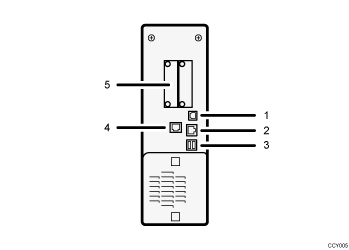Connecting to the Interface
This section explains how to identify the machine's interface and connect the machine according to the network environment.
![]()
|

USB 2.0 [Type B] port
Port for connecting the USB2.0 [Type B] interface cable
10BASE-T/100BASE-TX port
Port for connecting the 10BASE-T or 100BASE-TX cable
USB Host Interface
Port for connecting the USB interface cable
Use this interface to connect the machine to a card authentication device or memory card reader.
Gigabit Ethernet port (optional)
Port for using the 1000BASE-T, 100BASE-TX, or 10BASE-T cable
Slot A
Install the optional wireless LAN interface unit here.
The wireless LAN interface unit is required if you want to connect this machine to a wireless LAN. When installed in Slot A, this unit allows you to connect the machine to an IEEE 802.11 a or IEEE 802.11 b/g wireless LAN.
![]()
The Ethernet and Gigabit Ethernet port cannot be used simultaneously. If the optional Gigabit Ethernet board is installed, connect the Ethernet cable to the port on the Gigabit Ethernet board Communication with the machine will fail if cables are connected to both ports simultaneously.

